
This site celebrates the life and work of sculptor
John Cassidy (1860 - 1939).
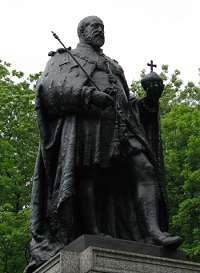
Above: After the 2008 restoration.
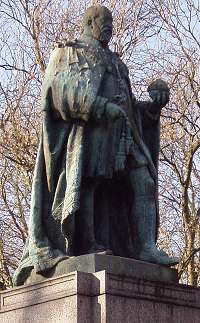
Before the restoration.
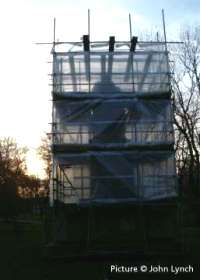
Restoration work under way, March 2008
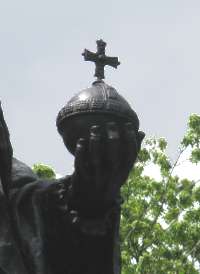
The new orb, 2008.
The King and Manchester

Edward visited Manchester several times: as Prince of Wales he opened the Royal Jubilee Exhibition of 1887, in which Cassidy participated and probably saw the King from a distance (illustration above from the Illustrated London News). As King he visited twice: once in 1905, and again in 1909 when he opened the Royal Infirmary, the building at which his statue still gazes at across the Oxford Road in 2008.
King Edward's visit to Manchester, 1905
Each year two provincial cities were favoured with a 'state visit' and that in 1905 Sheffield and Manchester were picked. The royal couple were to be guests at Knowsley Hall for for their visit to Manchester.
From The Times, July 12 1905:
"The train conveying the King [Edward VII] and Queen to Sheffield will leave St Pancras station at 10 o'clock this morning and, travelling via
Trent and the Erewash Valley, is due to arrive at Sheffield at 1 p.m. The 9.45 a.m. express, which runs to Sheffield without a stop, will act as pilot train. The Royal Party will leave Sheffield at 5 p.m., travelling by the Midland Railway via Dore and Chinley and Miles Platting and Victoria Stations (Manchester.) The London and North Western will then take charge of the train and work it to Huyton (for Knowsley) where it is due at 6.50 p.m. Last night's 'Gazette' contains a proclamation appointing tomorrow as a special day to
be observed as a Bank Holiday in Manchester, Salford and Stretford."
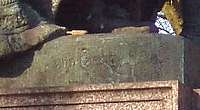
Cassidy's signature on the base
The Royal Visit, 1909
The King and his wife Queen Alexandra, who a couple of weeks earlier had opened the new main building of the Victoria and Albert Museum in London, another characteristically Edwardian building, again spent the night before their visit to Manchester at Knowsley Hall, the home of the Earl of Derby, better-known in more recent times for its safari park.
From The Times, 7 July 1909:
OPENING OF THE MANCHESTER INFIRMARY
The King and Queen, accompanied by Princess Victoria, travelled by train yesterday from Knowsley to Manchester, where his Majesty opened the new Manchester Royal Infirmary.
Sir Joseph Leese, M.P., Recorder of the City, read an address of welcome from the City Council. To this the King replied:-
'I thank you on behalf of the the Queen and myself for your loyal and dutiful address of welcome, and I assure you of the pleasure with which I have watched the progress which has taken place in the prosperity of Manchester, in the splendid industrial achievements of her citizens, and in the development of her public institutions. I am confident that in energy, in perseverance, and in ability the men of Manchester are to-day in no way behind their fathers. The welfare of your city will always be an object of my warmest interest.'
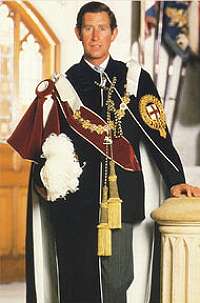
The current Prince of Wales, Prince Charles (1948- ) in his Garter robes.
Orb and Sceptre
Essential ceremonial accessories for the coronation of a British monarch are the orb and sceptre, both made for King Charles II’s coronation. The orb is a golden ball surmounted by a jewelled cross, to remind the monarch that there is a higher power than him or her.
Around 3ft long, the sceptre is a golden stick encrusted with hundreds of precious stones, including the largest, priceless fragment of the famous 530-carat Cullinan diamond, otherwise known as the Star of Africa.
Links and references:
Whitworth Park and Gallery feature in The Rusholme Archives
Whitworth Park (Manchester City Council)
The Whitworth Gallery
'The Manchester Whitworth Institute', by A. G. Temple. Burlington Magazine for Connoisseurs, Vol. 14, No. 68. (November 1908), pp. 101-102.
'Whitworth Institute: opening of the new galleries. Mr. Darbishire on the gifts to Manchester.' Manchester Guardian, 30 July 1908, p. 4.
'King Edward VII: Manchester statue unveiled', Manchester Guardian, 17 Oct 1913, p. 14.
The Crown Jewels
The Order of the Garter
Ede and Ravenscroft: maker of Garter Robes
King Edward VII, painting by Luke Fildes (Royal Collection)
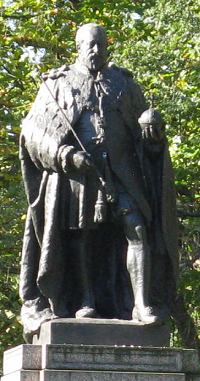
Autumn 2010
Special thanks for assistance with this item are due to John Lynch, Bruce Anderson of the Rusholme and Victoria Park Archive and Steve Parlanti of the Parlanti Bronze Founaries website.
King Edward VII, Whitworth Park, Manchester
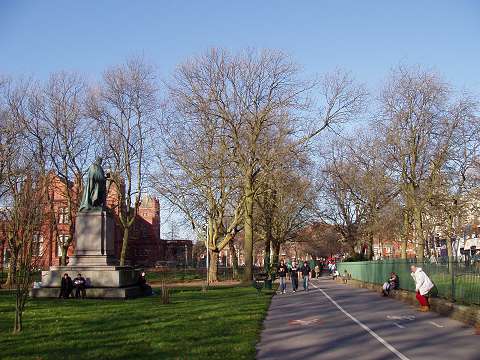
Whitworth Park lies alongside the Oxford Road opposite the Manchester Royal Infirmary, on the fringes of the area occupied by the University of Manchester. As you stand today in the park (the picture above looks towards the city centre) you are surrounded by Edwardian Manchester, with Cassidy's statue of the King himself presiding over the 1908 façade of the Art Gallery and, across the road, the Infirmary building also opened in 1908.
The park was created as part of the Whitworth Institute, a memorial tribute to Stockport-born engineer Sir Joseph Whitworth (1803-87), which also included the adjacent art gallery. Whitworth left 'vast sums' of money - over a million pounds according to one account - in his will, including legacies to his friends Robert Dukenfield Darbishire (a Manchester solicitor) and Richard Copley Christie (University professor and book collector whose books are now in the John Rylands Library) with general instructions as to how they might spend the money. Darbishire became Secretary of the Institute, which is recorded as having spent £198,648 by the year 1900 on the establishment of the gallery and park. The funds were supplemented by £45,000 from the profits of the Manchester Exhibition of 1887. John Cassidy served on the Governing Committee of the Institute.
The Institute secured the land for the Park (then known as Potter's Field) in 1889, and the Park was opened in 1890. The included a private residence called 'Grove House,' on the site of the current gallery,which became the first art gallery; extensions were later added at the rear, and the house itself was demolished in 1908 to make way for the present facade, designed by local architects J W and J Beaumont and built in Ruabon brick. The park was handed over to Manchester Corporation in October 1904 on a 1000-year lease for a nominal rent of £10 a year, and is still today operated by the city's Leisure Services. The Institute building is now the Whitworth Art Gallery, part of the University of Manchester since 1958, and open to the public, is well worth a visit.
The park originally had a lake, a bandstand and other attractions, but over the years this have been removed, to leave just a simple, but attractive, open space with mature trees and flowerbeds.
Albert Edward of Saxe-Coburg-Gotha (1841 - 1910), Prince of Wales, later King Edward VII of the United Kingdom, was the eldest son of Queen Victoria, and thanks to her long life did not become king until 1901, at the age of 59. The son of Queen Victoria, died on 6 May 1910 after a short reign of just over ten years which saw many changes which saw many changes in Britain, and has come to be called the Edwardian period. Perhaps after the long reign of Queen Victoria, people wanted something new in their lives.
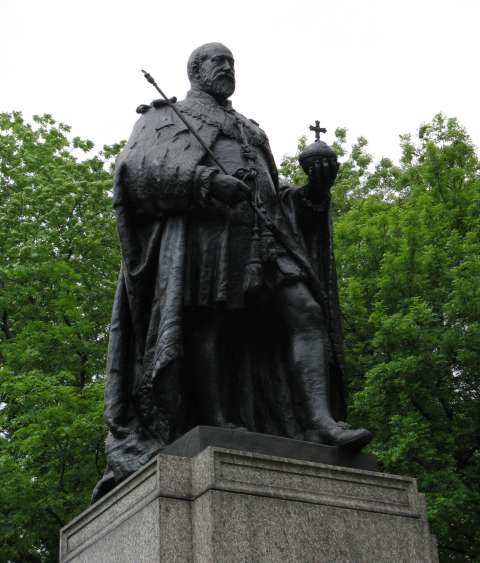
In Manchester, as around the country, there was a feeling that he should be commemorated, although commemorations were less enthusiastic than the wave of memorials that had followed the death of his mother. Terry Wyke writes:
In Manchester a committee
was set up in November 1910 to recommend the most
appropriate tribute to the late King's life and reign.
Reporting in the following May, it proposed a fund that
would provide both a statue and charitable assistance to
the old and poor in the city.
However. not all contributors to the fund were enthusiastic about the statue idea. While discussions were proceeding, James Gresham. a wealthy local engineer, had commissioned John Cassidy to create a statue of the late King. Gresham offered to donate this to the city, wishing it to be placed in the gardens which to be developed on the old site of the Royal Infirmary in Piccadilly. Gresham wanted the statue to be huge: about six metres (20 feet) tall on a nine-metre pedestal, making it one of the largest in the country.
The Manchester Guardian of 5 October 1911 (page 10) reproduced a photograph of Cassidy's original plaster model for the work, which was apparently based on an existing bronze bust of the monarch. It was proposed to model the King dressed in the robes of the Order of the Garter, rather than his (rather similar) Coronation robes which featured in a famous painting by Luke Fildes, or in military uniform as in some other representations. (The Order, consisting of the King and twenty-five knights, honours those who have held public office, who have contributed in a particular way to national life or who have served the Sovereign personally.) The king is depicted carrying the Orb and Sceptre, symbols of the monarch as carried at the Coronation.
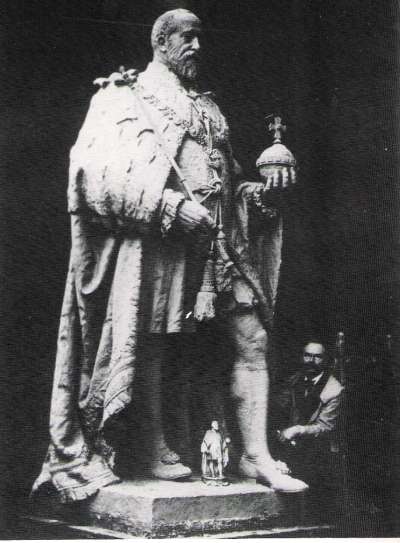
A fourteen-inch plaster model had been prepared, which would later be scaled up to a quarter-size model and finally a full-size plaster version (above, with Cassidy posing.) The first model differed in detail from the final statue; in particular, for some reason, the orb of office was to be surmounted by a 'winged horse of victory' rather than the simple cross which finally appeared. Cassidy told a reporter that creation of the statue would occupy him for two years, and in addition, three or four months for casting at the foundry.
The following day, 6 October, the Manchester Guardian's editorial writer offered the paper's opinion on the project:
Mr Cassidy is an sincere and
careful artist, to whose career we all wish well, but it
would be affectation to pretend that he ranks with the
handful of living sculptors whose imaginative fire and
force are tremendous enough to enable their work to
dominate with its dignity and nobility the greatest open
space of cities ... a twenty-foot statue in the centre of
a city cannot afford to be mediocre ... it must be great,
or it gibbets its sculptor and the municipality which
sanctioned it.
To the 21st-century mind, it would perhaps appear that even the greatest genius would struggle to make much of the figure of a rather fat old man. There was also some public disquiet that the choice of sculptor for such a memorial should be 'apparently determined by the predilection of a private owner.' This was a theme which ran through Cassidy's career; he was clearly a popular figure amongst wealthy Mancunian intellectuals.
After comments in the press and elsewhere, it was agreed that, rather than compete with the extravagant memorial in Piccadilly to Edward's mother Queen Victoria, the statue would be installed in the new Whitworth Park, and scaled down from the originally-planned size. The location was felt appropriate, as the King had opened the new Infirmary across the road on his last visit to the city.
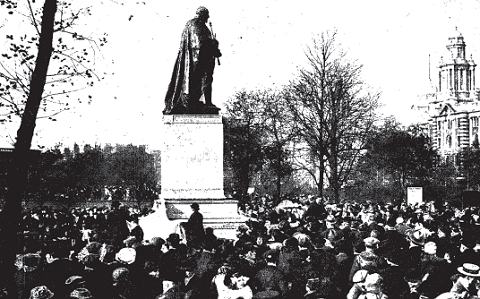
What emerged from the bronze foundry to be mounted on its grey granite pedestal for an unveiling (above) in October 1913 by the Lady Mayoress of Manchester, Lady Royse, was just three metres tall, although still impressive. The King in his full Garter regalia, originally complete with the Orb and Sceptre: sadly, tampering with the statue over the years led to the loss of the sceptre from the King's left hand and the cross from the top of the orb. The bronze casting was by Ercole Parlanti at his works at 59 Parson's Green, Fulham, London, whose brother Alessandro had founded the firm around 1895.
The 2008 refurbishment
Conservation work in the spring of 2008 included replacement of these by newly-cast replicas as well as a cleaning and re-patination of the the whole. Specialist portrait sculptor Tom Murphy was commissioned to create the missing features based on images of John Cassidy's original clay-figure and period drawings sent from the Tower of London. The conservation team ensured the use of the exact material composition for replacement castings, by conducting analysis of alloy samples of the original sculpture at The University of Manchester's Materials Science department. Once cast, the additions were aged and fitted to the monument using original methods. Other improvements included treatment of the metal surface to combat corrosion, the recasting and hand finishing of the lead lettering, the removal of graffiti from the plinth and the application of protective treatments to act against further graffiti, weather conditions etc.
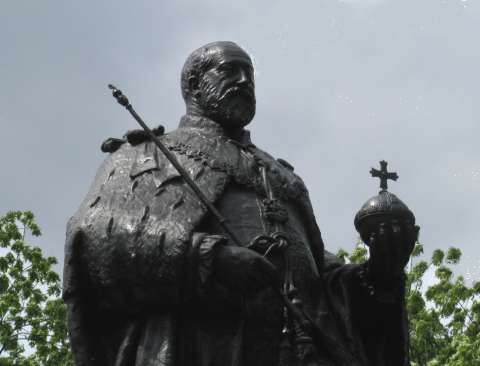
Congratulations to Manchester City Council for funding this work, and to the people who carried it out. Unfortunately, since these pictures were taken the pigeons have returned to their favourite perch...

Close-up showing the new sceptre.
Then and now
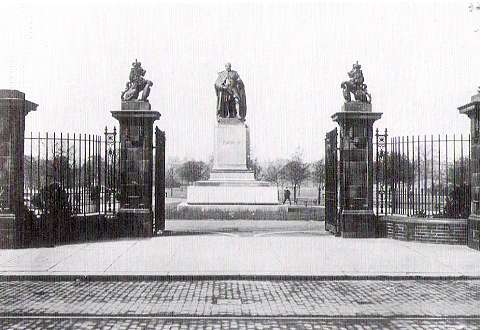
This old picture shows the view of the statue as seen through the wide gateway from Oxford Road which existed at the time. Note the tramway rails in Oxford Road, which lasted until the 1940s when buses took over on this road.
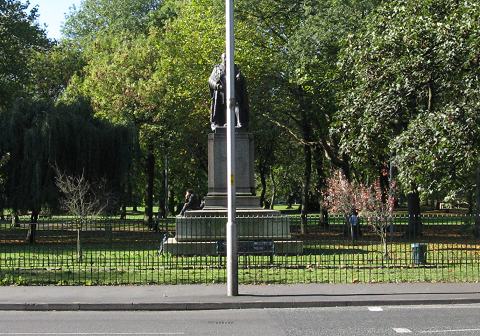
Unfortunately for the appearance of the statue to passers-by, this gateway no longer exists, replaced by railings and an unfortunately-placed lamp standard, as the 2010 view above shows.
Page created by Charlie Hulme 2007-2022.